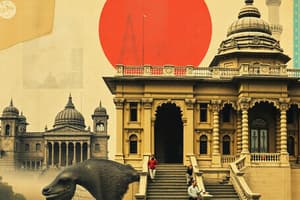Podcast
Questions and Answers
__ are small size paintings
__ are small size paintings
Miniatures
What are miniatures
What are miniatures
Miniatures are small sized paintings done in watercolor on clothes or paper on wood or palm this were on western India composed of jaina text the Mughal highly patronised it and appointed as skilled paintings
What did happen after the decline of Mughal emperor for the painters
What did happen after the decline of Mughal emperor for the painters
After the decline of Mughal Empire it spread into the regional states of the Deccan and the rajputs of Rajasthan. And these were depicted mythology and poetry. Mewar, Jodhpur ,Bundi ,Kota, Kishangarh
Another reason that attracted miniature paintings and explain what type was it?
Another reason that attracted miniature paintings and explain what type was it?
Write a short note on Kangra School of painting
Write a short note on Kangra School of painting
Write a short note on the the growth of the regional language
Write a short note on the the growth of the regional language
What was the language of administration when Bengal became a suba?
What was the language of administration when Bengal became a suba?
By which century did the Bengali group of dialects unite into a common literary language?
By which century did the Bengali group of dialects unite into a common literary language?
From which language is Bengali primarily derived?
From which language is Bengali primarily derived?
What are Mangalakavyas?
What are Mangalakavyas?
Which of these is an example of Bhakti literature?
Which of these is an example of Bhakti literature?
What is included in the second category of early Bengali literature?
What is included in the second category of early Bengali literature?
Who are the Naths?
Who are the Naths?
What did Maynamati encourage her son Gopichandra to do?
What did Maynamati encourage her son Gopichandra to do?
How is Dharma Thakur often worshipped?
How is Dharma Thakur often worshipped?
Texts belonging to the first category are easier to date because?
Texts belonging to the first category are easier to date because?
Flashcards
Miniatures
Miniatures
Small paintings, typically done on cloth or paper, with subjects ranging from religious themes to historical events.
Kangra School of Painting
Kangra School of Painting
A style of miniature painting that developed in the Kangra region of India during the 18th century. Known for its soft colors, delicate brushstrokes, and themes from Vaishnavite traditions.
Basoli Style
Basoli Style
A bold and distinct style of miniature painting that emerged in the Himalayan foothills around the 17th century. Featured in the artwork of Banudatta’s 'Rasamanjari'.
Post-Mughal Period
Post-Mughal Period
Signup and view all the flashcards
Jaina Text
Jaina Text
Signup and view all the flashcards
4th-7th Century India
4th-7th Century India
Signup and view all the flashcards
Bengali
Bengali
Signup and view all the flashcards
Early Bengali Literature
Early Bengali Literature
Signup and view all the flashcards
Mangalakavyas
Mangalakavyas
Signup and view all the flashcards
The Naths
The Naths
Signup and view all the flashcards
Maynamati
Maynamati
Signup and view all the flashcards
Dharma Thakur
Dharma Thakur
Signup and view all the flashcards
Pirs
Pirs
Signup and view all the flashcards
Study Notes
- Bengali as a regional language developed when Bengal was conquered.
- Persian was the language of administration.
- By the 15th century the Bengali dialects were united as a common literary language.
- This language was based on the spoken language of West Bengal.
- Bengali is derived from Sanskrit.
- It evolved through several stages.
- Non-Sanskrit words from tribal, Persian, and European languages became part of modern Bengali.
- Early Bengali literature is categorized as being either indebted to Sanskrit or independent of it.
- The first category includes translations of Sanskrit epics like the Mangalakavyas and bhakti literature.
- Mangalakavyas were auspicious poems about local deities.
- Bhakti literature can include biographies of Chaitanyadeva, who was the leader of the Vaishnava bhakti movement.
- The second category of Bengali literature includes Nath literature.
- Nath literature encompasses songs of Maynamati and Gopichandra.
- It includes stories concerning the worship of Dharma Thakur.
- Also includes fairy tales, folk tales, and ballads.
Maynamati, Gopichandra and Dharma Thakur
- The Naths were ascetics practicing varied yogic practices.
- A song describes Maynamati encouraging her son Gopichandra to adopt asceticism when facing obstacles.
- Dharma Thakur is a popular regional deity.
- Dharma Thakur is worshipped in the form of a stone or wood.
Dating Texts
- Texts from the first category are easier to date as many manuscripts have been found.
Studying That Suits You
Use AI to generate personalized quizzes and flashcards to suit your learning preferences.


